Dining car
A dining car (American English) or a restaurant car (British English), also a diner, is a railroad passenger car that serves meals in the manner of a full-service, sit-down restaurant.
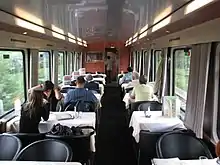
It is distinct from other railroad food service cars that do not duplicate the full-service restaurant experience, such as buffet cars, cars in which one purchases food from a walk-up counter to be consumed either within the car or elsewhere in the train. Grill cars, in which customers sit on stools at a counter and purchase and consume food cooked on a grill behind the counter are generally considered to be an "intermediate" type of dining car.
History
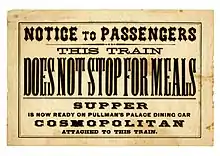
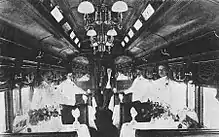
United States
Before dining cars in passenger trains were common in the United States, a rail passenger's option for meal service in transit was to patronize one of the roadhouses often located near the railroad's "water stops". Fare typically consisted of rancid meat, cold beans, and old coffee. Such poor conditions discouraged some from making the journey.
Most railroads began offering meal service on trains even before the First transcontinental railroad. By the mid-1880s, dedicated dining cars were a normal part of long-distance trains from Chicago to points west, save those of the Santa Fe Railway, which relied on America's first interstate network of restaurants to feed passengers en route. The "Harvey Houses", located strategically along the line, served top-quality meals to railroad patrons during water stops and other planned layovers and were favored over in-transit facilities for all trains operating west of Kansas City.
As competition among railroads intensified, dining car service was taken to new levels. When the Santa Fe unveiled its new Pleasure Dome lounge cars in 1951, the railroad introduced the travelling public to the Turquoise Room, promoted as "The only private dining room in the world on rails." The room accommodated 12 guests, and could be reserved anytime for private dinner or cocktail parties, or other special functions. The room was often used by celebrities and dignitaries traveling on the Super Chief.
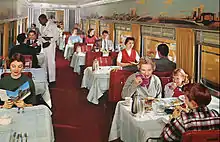
Edwin Kachel was a steward for more than twenty-five years in the Dining-Car Department of the Great Northern Railway. He said that "on a dining car, three elements can be considered -- the equipment, the employee, then passenger." In other words, "the whole is constituted by two-thirds of human parts."[1] As cross-country train travel became more commonplace, passengers began to expect high-quality food to be served at the meals on board. The level of meal service on trains in the 1920s and 1930s rivaled that of high-end restaurants and clubs.[2]
United Kingdom
They were first introduced in England on 1 November 1879 by the Great Northern Railway Company on services between Leeds and London. A Pullman car was attached to the train for the purpose.[3]
As of 2018, Great Western Railway is the only UK train company to provide a full dining Pullman service on selected trains to the West Country & Wales.
Food
Elegance is one of the main words used to describe the concept of dining on a train. Use of fresh ingredients was encouraged whenever possible. Some of the dishes prepared by chefs were: Braised Duck Cumberland, Hungarian Beef Goulash with Potato Dumplings, Lobster Americaine, Mountain Trout Au Bleu, Curry of Lamb Madras, Scalloped Brussels Sprouts, Pecan and Orange Sticks and Pennepicure Pie to name a few items.[2]
The Christmas menu for the Chicago, Milwaukee & St. Paul Railway in 1882 listed the following items: Hunter's Soup, Salmon with Hollandaise Sauce, Boned Pheasant in Aspic Jelly, Chicken Salad, Salmis Prairie Chicken, Oyster Patties, Rice Croquette, Roast Beef, English Ribs of Beef, Turkey with Cranberry Sauce, Stuffed Suckling Pig with Applesauce, Antelope Steak with Currant Jelly, potatoes, green peas, tomatoes, sweet potatoes, Mince Pie, Plum Pudding, Cake, Ice Cream, Fruits and coffee.[2]
Configuration
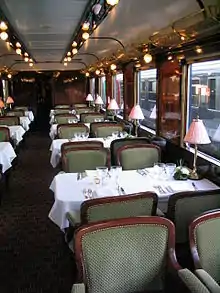
In one of the most common dining car configurations, one end of the car contains a galley (with an aisle next to it so that passengers can pass through the car to the rest of the train), and the other end has table or booth seating on either side of a center aisle.
Trains with high demand for dining car services sometimes feature "double-unit dining cars" consisting of two adjacent cars functioning to some extent as a single entity, generally with one car containing a galley as well as table or booth seating and the other car containing table or booth seating only.
In the dining cars of Amtrak's modern bilevel Superliner trains, booth seating on either side of a center aisle occupies almost the entire upper level, with a galley below; food is sent to the upper level on a dumbwaiter.
Dining cars enhance the familiar restaurant experience with the unique visual entertainment of the ever-changing view. While dining cars are less common today than in the past (having been supplemented or in some cases replaced altogether by other types of food-service cars), they still play a significant role in passenger railroading, especially on medium- and long-distance trains.
Today, a number of tourist-oriented railroads offer dinner excursions to capitalize on the public's fascination with the dining car experience.
The U76/U70 tram line between the German cities of Düsseldorf and Krefeld offers a Bistrowagen ("dining car" in German), where passengers can order drinks and snacks. That practice comes from the early 20th century, when interurban trams conveyed a dining car. Despite the introduction of modern tram units, four trams still have a Bistrowagen and operate every weekday.
Gallery

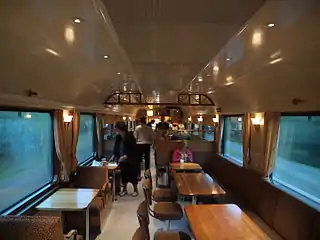
 Wagons-Lits dining car in Austria in 2003
Wagons-Lits dining car in Austria in 2003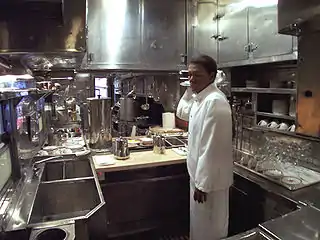 The pantry aboard former Santa Fe dining car #1474, the Cochiti. Over a million meals were served in the car, which remained in service through the late 1960s.
The pantry aboard former Santa Fe dining car #1474, the Cochiti. Over a million meals were served in the car, which remained in service through the late 1960s.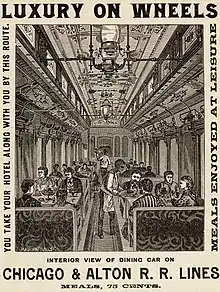 An 1880s print advertisement extolling the virtues of meal service aboard the Chicago and Alton Railroad
An 1880s print advertisement extolling the virtues of meal service aboard the Chicago and Alton Railroad Swiss Federal Railways Starbucks double-deck dining car
Swiss Federal Railways Starbucks double-deck dining car
See also
References
- Kachel, Edwin (1937), A Quarter of a Century with the Traveling Publi, Seattle: Progressive Printing Co., p. 27
- Porterfield, James D. (1993), Dining by Rail, New York: St. Martin's Griffin, ISBN 0-312-18711-4
- "Railway Dining Cars. Experimental Trip". Witney Express and Oxfordshire and Midland Counties Herald. England. 23 October 1879. Retrieved 29 July 2018 – via British Newspaper Archive.
Further reading
- Foster, George H.; Peter C. Weiglin (1992). The Harvey House Cookbook: Memories of Dining along the Santa Fe Railroad. Longstreet Press, Atlanta, GA. ISBN 1-56352-357-4.
- Luckin, Richard W. (1994). Mimbres to Mimbreño: A Study of Santa Fe's Famous China Pattern. RK Publishing, Golden, CO. ISBN 0-9626362-1-5.
- Luckin, Richard W., dir. (DVD) (2003). Super Chief: Speed-Style-Service. RK Publishing, Golden, CO.
{{cite book}}: CS1 maint: multiple names: authors list (link) - Porterfield, James D. (1993). Dining by Rail: The History and Recipes of America's Golden Age of Railroad Cuisine. St. Martin's Press, New York, NY. ISBN 0-312-18711-4.
- Schafer, Mike; Welsh, Joe (1997). Classic American Streamliners. Osceola, Wisconsin: MotorBooks International. ISBN 978-0-7603-0377-1.
- White, John H. (1985) [1978]. The American Railroad Passenger Car. Baltimore, Maryland: Johns Hopkins University Press. ISBN 978-0-8018-2743-3.
- Notes on W.A.G.R.'s Dining Cars Watson, L.G. Australian Railway Historical Society Bulletin, September 1982 pp194–213
- On-train Catering in New South Wales - 1921-2001 Banger, Chris Australian Railway Historical Society Bulletin, March to July 2004 pp102–118;123-141;188-198;222-237;264-279
External links
- Atchison, Topeka and Santa Fe Railway No. 1474 Cochiti — photographs and short history of a Super Chief Dining Car built in 1936.
- Erie Lackawanna Dining Car Preservation Society — restoration of two historic dining cars to recreate the dinner in the diner experience.
- Eureka Springs and North Arkansas Railway's dining car service
- https://web.archive.org/web/20141225025536/http://www.sta-dg.com/etransport/ - new dining car